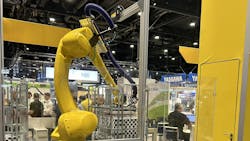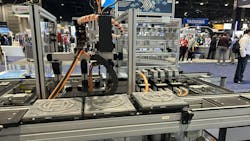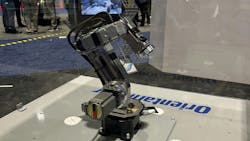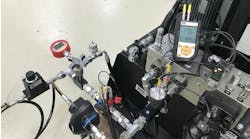Industrial automation continues to grow as a means of improving productivity as well as the quality of manufactured products. Robots of various types are enabling work to be done quickly and precisely, freeing up human workers to focus on other work.
They are also helping to keep humans from having to do some of the more dangerous or physically taxing jobs while also enabling work to be completed in those industries challenged with finding skilled workers.
Technological advancements in sensors, vision systems, motion control components and more are enabling greater adoption of robots and other automation solutions for various applications. Many of these developments were on display at Automate 2024 – an annual event which has become one of the largest focused specifically on automation technologies and robotics.
READ MORE: Automate 2024 to Spotlight Latest Robotics and Automation Technologies
After a record show in 2023 which prompted moving Automate to an annual occurrence due to strong industry demand, the 2024 edition is expected to be even larger (final figures not available at the time of publishing). Ever increasing interest in robots and other automation technologies is bringing about a need for more education on these solutions as well as better understanding of how to choose the right option which the Association for Advancing Automation (A3) aims to provide through its event.
During Automate 2024, Power & Motion spoke with Clarissa Schwendeman, Director of Marketing, and Alex Shikany, Vice President of Membership & Business Intelligence, at A3 to learn more about current trends they are seeing in the automation industry and how they see it progressing in the future.
*Editor’s Note: Questions and responses have been edited for clarity.
Power & Motion (P&M): What are some of the major trends A3 is seeing within the automation market at the moment? Are there certain technologies or applications it sees really helping drive automation uptake?
Clarissa Schwendeman (CS): The first one that comes to mind is mobile robotics. Using mobile robots in factories really helps with dull, dirty, dangerous [jobs]…fills that labor gap. And they’re [manufacturers] making them a lot easier to use.
Alex Shikany (AS): Robots are a huge one. You see more collaborative [robot] arms this year on top of mobile robots doing interesting things. Also, vision technology is very big. There are solutions with all three that we’ve talked about so far.
One that I saw has cameras on a collaborative robot arm that can actually help precisely locate the AMR (autonomous mobile robot) because there’s very tight tolerances, so it can move and get different angles and zero in. So, we’re seeing collaboration among technologies even more this year.
READ MORE: Rapid Growth Ahead for Mobile Robot Components Market
P&M: Do you think that’s going to be a growing trend, more technologies coming together like that?
CS: I think the integration of technology is definitely a trend that is happening.
P&M: Are there specific technologies A3 is hearing from members they want to learn more about, or they feel there is not enough information yet in the market about?
CS: Industrial AI (artificial intelligence) is starting to grow; simulation technologies to learn ‘What can we have in our factory? Is this the most efficient application to bring in?’ That’s the one I’ve heard most about.
AS: AI, that’s got to be number one. At A3, we have our first version of our AI training that we are now are doing here [at Automate] actually, and we’re running it again in the fall at our AI and Smart Automation Conference. That’s a huge value to the industry because we already have certification programs for vision and motion, now we can add AI to that list eventually, that’s the goal, so that’s a huge one.
I can’t say enough about humanoids either, that’s a huge topic. There’s some here, [and] we just launched a new event [on the topic].
P&M: Are there challenges with implementing or learning about what automation technologies are out there you’re hearing from members, or what are their biggest struggles?
CS: I’ll speak to the big companies that are trying to start using automation, one of the challenges is where do you even begin? What is automatable? And should we automate that? Some of the advice we’ve heard from our members that do provide these technologies is start small.
One of the other things is data. We collect so much data, what do you do with it? How do you most efficiently use it? That’s part of it as well.
AS: You have to be smart about your data. I think that’s where a lot of these AI software solution companies are finding a good foothold in the industry because their service allows you to make better sense of your data and deploy it in decision-making ways that are not just ‘Okay, we’re collecting all this now, what do we do with it?’ That’s definitely a challenge.
Starting small, starting smart, but starting generally – we get a lot of people here that this is their first foray into automation. We heard someone just familiarize themselves earlier in the morning with the term cobot; so we know, we hear from people that this is where they come to embark on their [automation] journey. Frankly, they’ve already achieved or overcome a challenge by getting here to the show because they’re on the path now and getting started is a huge opportunity.
P&M: Is A3 trying to do anything with the show to further help overcome those challenges and help people get started along that path? Is the association trying to maybe refocus some of its sessions or is there anything with how it’s trying to present the show in any way?
CS: Absolutely. Specifically, our Automate conference – we have gotten attendee feedback, we are talking to people in the industry, we are learning what people want to know more about. This year we have close to 200 conference sessions about all these topics, nine breakout rooms on top of the Automate Theater and Innovation Center. We are providing so much education on what you can possibly know.
AS: It’s indicative of the interest. I believe the numbers are bearing out already it’s going to be the largest conference we’ve ever held among those nine [breakout] rooms, so the most amount of demand. These are paying customers, so they’re paying to get that deep level of information.
We have sessions on beginning in robotics, fundamentals of machine vision; to your point about overcoming challenges, we give them that entry level [information] and the middle and the advanced. We try to cover the whole spectrum.
We have so many system integrators at the show. For years they were in their own pavilion section, [but] we made it a very forward-facing part of the show because integrators bring all these technologies together. They work very closely with the end user, so they’re a great resource to ask questions. You’re not in it alone when you come here. You’ve got people here who can tell you that you’ve got to consider this and that.
CS: We also look ahead and do our research ahead of time on what are people looking to find in the show and publish on our website what to expect, the biggest trends and useful conference sessions the most amount of people may be interested in.
P&M: From your perspectives, what are some of the biggest technological advancements you have seen in the last 5 years for automation? Is it the mobile robots we talked about earlier or are there other technologies you’ve seen progress and advance?
CS: I think vision technology…the precision to pick stuff up is one example. The other is bin picking – if you need to sort dinged up bottles from good bottles, having clearer vision to distinguish that faster has been one of the advancements.
AS: It speaks to where we started with the convergence of the technology. Step back 5 years ago, a lot of technologies were budding that we’ve been talking about but they were not all working together in ways that help solve unique challenges for people. We were still learning, AMRs were coming onto the scene, people were not sure really if they were going to pick up.
Now they’re in almost every warehouse and fulfillment center, Amazon’s deployed hundreds of thousands of robots. And they have all that vision and sensor [technology] so human workers can work right alongside them safely. That’s a huge thing, safety. I would say the developments in being able to understand when you put something like this in your operation and your human employees are not at risk. The human collaboration with the tools has come a long way.
And of course AI is a huge development as of late, and we’ll still learn more as we go on.
READ MORE: Machine Vision Market to Grow Through 2028
P&M: Where do you see automation technology or the industry in general going in the next 2-3 or 5 years?
CS: Hopefully touching more industries. At our Women’s Empowerment Forum, our sponsor United Robotics Group brought in one of their serving robots; they focus on the restaurant industry. But on the safety point that Alex was talking about, people were coming in and out [of the forum] and this robot was navigating through very safely. It could easily identify a person. Restaurants are a growth industry. Agriculture has been huge and medical.
AS: It’s the new industries and customers finding value out of what they can do with these technologies. There is a lot of opportunity out there. And more convergence of technology. You see a lot of new players coming on the scene; there are a lot of players that are driving the convergence of new products that have all of these things woven in. And certainly, that's not to exclude the major manufacturers that are already working really hard to do the same thing, but they're all kind of marching along that path.
CS: Adoption of robots [is growing]; even small- and mid-sized people who need it the most are going to figure out [automation is possible]. There are out-of-the-box robots where you can just purchase it, it is very easy to use and apply it to whatever you want, starting small. And [companies] are offering training programs too.
AS: There are also different funding models available now. Robots as a service is another option for people. There are a lot of factors around affordability of robotics, cost of capital, CapEx or OpEx (capital expenditures or operating expenses). These are all decisions for customers when they decide they want to invest. But the industry Is becoming more sophisticated. These companies are all offering pretty much any option to them so it [costs] wouldn’t be a barrier anymore. It wasn’t always the case, but it’s more so the case now.
P&M: Do you see the show, which is focused on the industrial manufacturing sector, expanding to include industries in which automation is taking place such as mobile equipment like agricultural machinery? Or is A3 really trying to focus on automation for the industrial sector?
AS: I definitely could see that being a growth path for us. You mentioned some industries that are adopting more and more of these technologies, agriculture they have some robotics, there’s also service robots and exoskeletons. You’ve seen some international shows bring those in recent years. I think it’s a natural outgrowth potentially as more people learn about these technologies for industrial use cases, technology becomes more ubiquitous, you can apply it in different ways.
I’m a little biased but I see the sky’s the limit for these technologies. We’re going to have home robots eventually; we already have vacuum cleaners. Our keynote Daniela Rus from MIT is really big into research and forward thinking about what’s coming [in the future]. There’s some really interesting training robots with human movements using sensors…I’m pouring water into a cup and the robot system literally learns from my movements and can do the exact same thing; you don’t have to program it. That’s the type of future I see.







